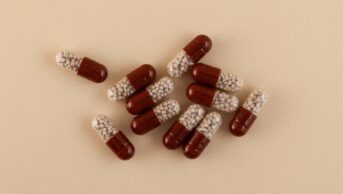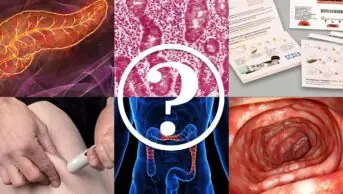
Shutterstock.com
After reading this article, you should be able to:
- Recognise the signs, symptoms and mechanisms of gastro-oesophageal reflux disease (GORD);
- Offer medical management and lifestyle advice to patients with GORD;
- Understand when and where to refer patients.
Gastro-oesophageal reflux disease (GORD) is a chronic condition in which gastric contents — namely acid, bile and pepsin — reflux into the oesophagus, causing the patient to experience symptoms of heartburn and acid regurgitation[1,2]. GORD is usually diagnosed symptomatically, by the occurrence of heartburn on two or more days per week[3]. An initial trial of proton-pump inhibitor (PPI) therapy in adults presenting with typical GORD symptoms is a reasonable option[4,5].
The prevalence of GORD worldwide is increasing and this has been linked to the obesity epidemic and an ageing population[6]. GORD has a significant economic burden globally — recent studies estimate the resource implications to be approximately £760m per year in the UK alone[7].
If acid reflux continues for a prolonged period of time, it can lead to oesophagitis, benign oesophageal stricture and Barrett’s oesophagus[8]. Approximately 10–15% of patients who have GORD will go on to develop Barrett’s oesophagus and, of these, 1–10% will develop an oesophageal adenocarcinoma over the next 10–20 years[9].
Mechanisms of GORD include reduced tone of the lower oesophageal sphincter, hiatal hernia, increased hydrochloric acid production and high intragastric pressure (see Table 1)[10].
Symptoms
The main symptoms of GORD are heartburn and acid reflux, but other symptoms include:
- Bloating and belching;
- Nausea;
- Persistent cough or wheezing, which may be worse at night;
- Sore throat and hoarse voice;
- Bad breath;
- Tooth decay and gum disease.
Symptoms are often worse after eating large meals, when lying down and when bending over. Patients who have a diagnosis of asthma may see a deterioration in their condition as a result of stomach acid irritating the airways[11,12].
More severe, or ‘red-flag’, symptoms can be remembered with the acronym ‘ALARMS’[13]:
- Anaemia;
- Loss of weight;
- Anorexia or vomiting;
- Refractory to antisecretory medicines;
- Malena (black, sticky stools);
- Swallowing problems (dysphagia).
These red flag symptoms are signs of differential diagnosis including, but not limited to, upper gastrointestinal malignancy, peptic ulcer disease, coeliac disease, pancreatitis, inflammatory bowel disease and coronary artery disease[1,5,10].
Diagnosis
An appropriate history of the symptoms should be taken from the patient, including frequency, severity, timing (day or night) and duration of symptoms, as well as any specific triggers (e.g. diet)[5]. It is also important to take a medication history to ensure the patient is not on any medicines that can cause or exacerbate GORD, such as non-steroidal anti-inflammatory drugs (NSAIDs), bisphosphonates, calcium channel blockers, corticosteroids, alpha blockers, anticholinergics and tricyclic antidepressants[2,14].
National guidelines recommend that patients presenting with classic symptoms of GORD — heartburn and regurgitation — who are not experiencing any red-flag symptoms should be started on a four-week trial of empiric PPI once daily as a way of confirming the diagnosis[15,16].
Endoscopy should be reserved for patients who do not respond to a trial of PPI therapy or for those whom oesophageal cancer is suspected[17,18]. Patients should be offered urgent direct access to endoscopy via the two-week wait pathway to assess for oesophageal cancer in those who present with dysphagia or who are aged over 55 years with weight loss and any of the following:
- Upper abdominal pain;
- Reflux;
- Dyspepsia.
Non-urgent, direct access to an upper gastrointestinal endoscopy should be considered to investigate for oesophageal cancer in people aged 55 years or over with[18]:
- Treatment-resistant dyspepsia; OR
- Upper abdominal pain with a low haemoglobin; OR
- Raised platelet count with any of the following:
- Nausea;
- Vomiting;
- Weight loss;
- Reflux;
- Dyspepsia;
- Upper abdominal pain; OR
- Nausea or vomiting with any of the following:
- Weight loss;
- Reflux;
- Dyspepsia;
- Upper abdominal pain.
Treatment options
Medicines known to cause or exacerbate symptoms of GORD should be reviewed, reduced and ceased if appropriate[2]. This will require an appropriate consultation with the patient with shared decision making.
Short-term, symptom-control management of GORD can be done with antacids and/or alginates; however, long-term, continuous use of these is not recommended[2]. It is also worth noting that antacids and alginates can affect the absorption of other medications and therefore antacids/alginates should not be taken within one to two hours of other medicines[19].
Patients with proven or unproven GORD should be treated with a full-dose PPI for four to eight weeks, according to the National Institute for Health and Care Excellence (NICE)[16].
If patients fail to respond, or have an inadequate response, to treatment with a PPI, an H2-receptor antagonist can be considered as an alternative therapy option[2,16].
Helicobacter pylori testing is not recommended in patients with proven oesophagitis or symptoms suggestive of GORD; however, patients who have no red-flag symptoms, have failed to respond to lifestyle changes and antacids following a four-week trial of PPI therapy should be tested for H. Pylori[2,20]. H. Pylori testing should not be performed within two weeks of treatment with a PPI, as this may lead to false-negative results[2].
Lifestyle advice
Lifestyle changes can help with symptom control[2,8,21]. These include losing weight, stopping smoking, drinking less alcohol, reducing the amount of caffeine consumed, having small, regular meals, taking regular exercise and avoiding eating in the three to four hours before bed. Avoiding trigger foods (e.g. spicy foods, citrus fruits, tomatoes, onions, chocolate and fizzy drinks) can also be beneficial for some patients; however, triggers can be very individual and there is no single approach that will work for everyone[21]. Raising the head of the bed by around 15cm can also help manage GORD symptoms[17]. This can be done by placing blocks under the legs at the head of the bed, by using a wedge pillow or by placing a wedge underneath the mattress.
Case study 1
Andrew, aged 36 years, presents at his community pharmacy to ask for treatment to help with heartburn.
Andrew says he has been experiencing pain and burning in his chest and throat for the past two weeks, which gets considerably worse after eating. He divulges that he has been stressed recently because of the breakdown of his relationship and has ‘not been taking care of himself’. He explains that he has put on around three stone and often eats unhealthy snacks and takeaways.
He smokes around ten cigarettes per day and has thought about quitting in the past, but has never seen this through. He does not drink alcohol on a regular basis but will have the odd pint at a family gathering.
He has not tried anything to manage his symptoms yet but has seen adverts for indigestion products and wondered if that might help.
The patient does not have any red-flag signs or symptoms, is not on any medicines and has no allergies.
The pharmacist decides to offer Andrew a trial of a PPI, instead of an indigestion product, because his symptoms are suggestive of GORD. The patient is offered counselling points on the PPI and is also offered lifestyle advice to help reduce his symptoms.
Counselling points:
- PPIs should be taken 30–60 minutes before food, usually in a morning if taken once a day;
- PPIs are generally well tolerated, but common side effects include constipation, diarrhoea, headache and nausea and vomiting;
- Andrew should trial the PPI for up to four weeks and if symptom control has not been achieved, further investigation is recommended[22]. If symptoms worsen or red-flag symptoms are experienced, Andrew should report to the appropriate place (e.g. the hospital if he shows signs of bleeding);
- Andrew should try to eat smaller, healthier more frequent meals and try and eat his last meal of the day no later than three hours before he goes to bed. He could be signposted to the government ‘Eatwell’ campaign that provides useful hints and tips on a health balanced diet[23];
- The pharmacist could reinforce the benefits of regular exercise and maintaining a healthy body weight;
- Smoking cessation advice and support could be offered with a discussion started about nicotine replacement therapy;
- Consider talking therapies for stress if the patient deems it appropriate.
Case study 2
Paula, aged 57 years, attends a pharmacist-led clinic for a medication review. She has well-controlled asthma that is managed with a steroid inhaler and, when required, a salbutamol inhaler (which she rarely uses). Recently she developed sciatica, for which she has been started on pain medicines including co-codamol, naproxen and amitriptyline. Her breathing has not been affected by naproxen, but she has been experiencing symptoms of heartburn, an acidic/sour taste in her mouth and nausea but no vomiting.
She has already tried milk of magnesia and indigestion tablets, which she obtained from her local supermarket, but they have had no effect.
The pharmacist explains to Paula that her symptoms sound like gastro-oesophageal reflux disease, which could be linked to her naproxen and amitriptyline. Differential diagnosis include erosive oesophagitis, Barrett’s oesophagus, peptic ulcer disease, gastroparesis and oesophageal cancer.
Management:
- Stop naproxen until investigations completed — if all tests/investigations are negative this could be restarted with a PPI if essential;
- Consider an amitriptyline dose reduction or switch to an alternative agent for neuropathic pain, such as gabapentin;
- Give laxative advice while Paula is taking co-codamol;
- Ensure a blood test is completed to check for anaemia (a red-flag symptom);
- Consider non-urgent, direct-access upper gastrointestinal endoscopy to assess for oesophageal cancer, as Paula is >55 years, has nausea and reflux symptoms[18].
Case study 3
Simon, aged 58 years, is admitted to hospital because of dysphagia, which has been getting progressively worse. He is no longer able to tolerate solid food and is only managing liquids. Simon has lost about half a stone in the last two months but is still significantly overweight (BMI 34kg/m2). He has a long history of GORD and has been taking omeprazole 20mg once a day for about five years, although he admits that he often forgets to take it.
Simon is an ex-smoker and has been for about five years, since he suffered from a transient ischaemic attack. He is allergic to aspirin and is currently prescribed clopidogrel, atorvastatin, ramipril and omeprazole.
Simon undergoes an oesophago-gastro-duodenoscopy and is found to have a 3cm segment of Barrett’s oesophagus. He also has a stricture that requires dilatation. Biopsies are taken during endoscopy to confirm the diagnosis. The endoscopist recommends double-dose PPI: omeprazole 40mg once a day.
The pharmacist on the ward is reviewing new patients to the ward and finds that Simon has been prescribed omeprazole 40mg once a day for Barrett’s oesophagus. Simon is also on clopidogrel, so it is advised that the omeprazole is switched to lansoprazole owing to the known interaction between omeprazole and clopidogrel[2]. Also, lansoprazole oral bioavailability is around 80–90%, whereas omeprazole is around 40%[22,24]. The pharmacist recommends a dose of 30mg twice a day, which is off-licence for GORD, but as Simon had already been on a full-dose PPI prior to this admission it would be sensible to offer a higher dose in the acute phase (around four to eight weeks) and then reduce to full-dose lansoprazole 30mg once a day[16]. NICE guidelines indicate that Simon will need to remain on this long term because he has received dilatation[16].
Barrett’s oesophagus is a pre-malignant condition; therefore, regular endoscopic surveillance is required to monitor for development of adenocarcinoma[17,25]. According to NICE guidelines, this should be done every two to three years (as the patient’s segment of Barrett’s is 3cm and therefore defined as a long segment)[26].
- 1Dyspepsia – unidentified cause. National Institute for Health and Care Excellence . 2024. https://cks.nice.org.uk/topics/dyspepsia-unidentified-cause (accessed March 2024)
- 2Medicines Complete. Medicines Complete. 2023. http://www.medicinescomplete.com (accessed March 2024)
- 3Pithawa A. Sleisenger and Fordtran’s Gastrointestinal and Liver Disease: pathophysiology, diagnosis, management. Medical Journal Armed Forces India. 2007;63:205. https://doi.org/10.1016/s0377-1237(07)80085-2
- 4Chen JW, Vela MF, Peterson KA, et al. AGA Clinical Practice Update on the Diagnosis and Management of Extraesophageal Gastroesophageal Reflux Disease: Expert Review. Clinical Gastroenterology and Hepatology. 2023;21:1414-1421.e3. https://doi.org/10.1016/j.cgh.2023.01.040
- 5Gastro-oesophageal reflux disease. BMJ Best Practice. 2022. https://bestpractice.bmj.com/topics/en-gb/82#:~:text=The%20classic%20symptoms%20are%20heartburn,%2C%20weight%20loss%2C%20anaemia). (accessed March 2024)
- 6Sweis R, Fox M. The global burden of gastro-oesophageal reflux disease: more than just heartburn and regurgitation. The Lancet Gastroenterology & Hepatology. 2020;5:519–21. https://doi.org/10.1016/s2468-1253(20)30002-9
- 7Nirwan JS, Hasan SS, Babar Z-U-D, et al. Global Prevalence and Risk Factors of Gastro-oesophageal Reflux Disease (GORD): Systematic Review with Meta-analysis. Sci Rep. 2020;10. https://doi.org/10.1038/s41598-020-62795-1
- 8Badiu C. Oxford Handbook of Clinical Medicine (10 Ed.). Acta Endo (Buc). 2019;15:144–144. https://doi.org/10.4183/aeb.2019.144
- 9Dyspepsia – Proven GORD. National Institute for Health and Care Excellence . 2023. https://cks.nice.org.uk/topics/dyspepsia-proven-gord/ (accessed March 2024)
- 10Antunes C, Aleem A, Curtis S. statpearls. Published Online First: 3 July 2023.
- 11Heartburn and acid reflux. NHS. 2019. https://www.nhs.uk/conditions/heartburn-and-acid-reflux/ (accessed March 2024)
- 12Gastro-esophageal Reflux Disease . NHS Inform. 2023. https://www.nhsinform.scot/illnesses-and-conditions/stomach-liver-and-gastrointestinal-tract/gastro-oesophageal-reflux-disease-gord/#symptoms-of-gord (accessed March 2024)
- 13Collins P. Crash Course: Gastroenterology. 3rd ed. Elsevier 2008. https://shop.elsevier.com/books/crash-course-gastroenterology/collins/978-0-7234-3470-2 (accessed March 2024)
- 14Summers A, Khan Z. Managing dyspepsia in primary care. Practitioner. 2009;253:23–7, 2–3.
- 15Katz PO, Dunbar KB, Schnoll-Sussman FH, et al. ACG Clinical Guideline for the Diagnosis and Management of Gastroesophageal Reflux Disease. Am J Gastroenterol. 2021;117:27–56. https://doi.org/10.14309/ajg.0000000000001538
- 16Gastro-Oesophageal Reflux Disease and Dyspepsia in Adults: Investigation and Management [CG184]. National Institute for Health and Care Excellence . 2014. https://www.nice.org.uk/Guidance/CG184 (accessed March 2024)
- 17Lynch K. Gastroesophageal Reflux Disease . MSD Manual Professional Edition. 2024. https://www.msdmanuals.com/en-gb/professional/gastrointestinal-disorders/esophageal-and-swallowing-disorders/gastroesophageal-reflux-disease-gerd (accessed March 2024)
- 18Suspected Cancer: Recognition and Referral [NG12]. National Institute for Health and Care Excellence . 2021. https://www.nice.org.uk/guidance/ng12 (accessed March 2024)
- 19Peptac Peppermint Liquid. Summary of Product Characteristics (SmPC). Electronic Medicines Compendium. 2023. https://www.medicines.org.uk/emc/product/15318 (accessed March 2024)
- 20Test and Treat for Helicobacter Pylori (HP) in Dyspepsia. Quick reference guide for primary care: for consultation and local adaptation. Public Health England. 2017. https://assets.publishing.service.gov.uk/media/5d6ceea740f0b607c946aa65/HP_Quick_Reference_Guide_v18.0_August_2019_change_highlighted.pdf (accessed March 2024)
- 21All You Need to Know About Heartburn and Reflux. Guts UK. 2023. https://gutscharity.org.uk/advice-and-information/symptoms/heartburn-and-reflux/ (accessed March 2024)
- 22Omeprazole 20 mg gastro-resistant tablets. Summary of Product Characteristics (SmPC). Electronic Medicines Compendium. 2024. https://www.medicines.org.uk/emc/product/663/smpc (accessed March 2024)
- 23The Eatwell Guide. Public Health England. 2016. https://www.gov.uk/government/publications/the-eatwell-guide (accessed March 2024)
- 24Lansoprazole 30 mg gastro-resistant capsules, hard. Summary of Product Characteristics (SmPC). Electronic Medicines Compendium. 2023. https://www.medicines.org.uk/emc/product/14551/smpc (accessed March 2024)
- 25Barrett’s oesophagus and stage 1 oesophageal adenocarcinoma: monitoring and management [NG231]. National Institute for Health and Care Excellence . 2023. https://www.nice.org.uk/guidance/ng231/chapter/Recommendations#endoscopic-surveillance (accessed March 2024)
- 26McDaniel M, Conran RM. Educational Case: Barrett Esophagus. Academic Pathology. 2019;6:2374289519848089. https://doi.org/10.1177/2374289519848089
1 comment
You must be logged in to post a comment.



Great article and a very useful case study.